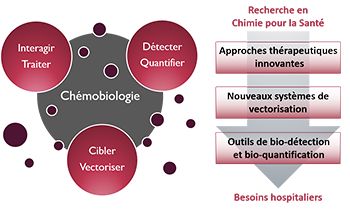- ⌂
-
Le DPM
Les Equipements
L'Environnement
Zoom sur... Le Bâtiment André Rassat
Nommé d'après une figure tutélaire de la chimie grenobloise, ce bâtiment est recouvert d’une double peau en feuille métallique qui apporte une protection thermique sur 3 côtés et crée une unité architecturale favorisant l'intégration parmi les arbres du site.
-
Thématiques
Le Thème
« Approches thérapeutiques innovantes »De nouvelles solutions thérapeutiques, de la cible biomacromolécu-laire émergente aux approches originales pour traiter les maladies
Le Thème
« Nouveaux systèmes de vectorisation »Combiner les propriétés d’inclusion de principes actifs, de franchisse-ment de barrières, d’adressage et de relar-gage en milieu vivant
Le Thème
« Outils de bio-détection et bio-quantification »Des dispositifs analytiques originaux pour la détection de cibles, de l’ion au micro-organisme en milieu complexe
Zoom sur... La Chémobiologie

-
Équipes
L'Équipe « COMET »
« COMET » développe la conception rationnelle, la synthèse et/ou l'extraction de composés à forte diversité/complexité comme nouveaux agents thérapeutiques et outils moléculaires pour la pénétration cellulaire ou la détection de biomolécules, actifs in vivo.L'Équipe « NOVA »
« NOVA » utilise des acides nucléiques fonctionnels comme éléments de reconnaissance pour des applications thérapeutiques ou diagnostiques, comme la sélection d'oligonucléotides, ou le développement de dispositifs d'analyses et de nanovecteurs.Les Services
-
Productions
Les Publications
La Vulgarisation
Les JSM
Zoom sur... La 12ème JSM (15 juin 2023)
Le DPM organise des journées scientifiques consacrées au médicament. L'objectif est de rassembler les spécialistes académiques et industriels autour d'une thématique. 2023 : Apports de la Chimie Click et de la Lumière en Chemobiologie
-
Partenariats
Les Formations
Les Consortiums
Les Financements
Zoom sur... L'environnement Grenoblois
Le DPM est un acteur central sur le bassin grenoblois en chimie, biologie et santé, lié au CHU Grenoble Alpes et à de nombreuses autres organisations : Pole de Recherche CBS, ICMG, Labex ARCANE, EUR CBH, Institut Carnot Polynat, Réseau GREEN.
Article
- Projet
- Eric PEYRIN, Corinne RAVELET,
- Titre
- An improved design of the kissing complex-based aptasensor for the detection of adenosine
-
[Full paper
 ]
] - Auteurs
- E Goux, S Lisi, C Ravelet, G Durand, E Fiore, E Dausse, JJ Toulmé, E Peyrin
- Edition
- Anal. Bioanal. Chem. 2015, 407, 6515-6524.
- Année
- 2015
- Résumé
- We very recently reported a novel aptamer biosensing concept based on a dual recognition mechanism originating from the small target-induced formation of a functional nucleic acid assembly. This assembly is constituted of a hairpin aptamer (named aptaswitch) for which the apical loop of the parent aptamer is substituted by a short RNA sequence prone to loop-loop interactions. It can switch between folded and unfolded states in the presence and in the absence of targets, respectively. The apical loop of the folded aptaswitch is then recognized by a second hairpin (called aptakiss), forming a kissing complex that signals the presence of the target. In the present work, we focus on the design improvement of this biosensing platform by using a previously described adenosine-adenoswitch couple as a model system and a fluorophore-labeled aptakiss as a reporting probe for fluorescence anisotropy (FA) detection. In the first step, the initially described adenoswitch was re-engineered to optimally convert the unfolded structure into the active stem-loop form upon adenosine binding. To further improve the assay performance, a blocking DNA oligonucleotide of the adenoswitch sequence was subsequently introduced into the assay scheme. This blocking strategy led to a significant increase in the FA response by reducing the background signal generated by the undesired binding of the free adenoswitch to the aptakiss probe. We obtained a detection limit which is fivefold lower than that observed with the previously reported kissing complex-based sensor. Finally, the optimized biosensing platform was successfully applied under biologically relevant conditions, i.e., diluted human serum, suggesting the potential practical applicability of the kissing sensing approach.




 Annuaire
Annuaire Contact
Contact Plan d'accès
Plan d'accès ENG
ENG Login
Login



